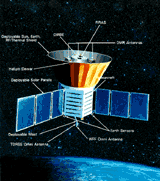COBE
Cosmic Background Explorer
 COBE is designed to look back to within one year of the Big Bang and help answer questions of fundamental importance to astronomy. COBE's observations of diffuse cosmic background radiation will help answer basic questions such as whether the matter in the universe is homogenously distributed, whether the universe is uniformly expanding and rotating, and how and when stars and galaxies first formed. COBE will also map interstellar and interplantetary dust clouds. Originally planned for launch on the Shuttle, COBE was redesigned for launch aboard a Delta 2 following the Challenger disaster. COBE's supply of liquid helium was exhausted in September 1990, causing loss of the FIRAS instrument.
COBE is designed to look back to within one year of the Big Bang and help answer questions of fundamental importance to astronomy. COBE's observations of diffuse cosmic background radiation will help answer basic questions such as whether the matter in the universe is homogenously distributed, whether the universe is uniformly expanding and rotating, and how and when stars and galaxies first formed. COBE will also map interstellar and interplantetary dust clouds. Originally planned for launch on the Shuttle, COBE was redesigned for launch aboard a Delta 2 following the Challenger disaster. COBE's supply of liquid helium was exhausted in September 1990, causing loss of the FIRAS instrument.
Spacecraft
Spin stabilizion (0.8 rpm about sunline) using 3 reaction wheels, torque rods. Attitude control knowledge (4 arcmin) provided by magnetometers, earth sensors, sun sensors, gyros. Hexagonal spacecraft bus. Cryostat containing 95.7 kg of liquid helium for cooling sensors, protected against solar and terrestrial radiation provided by conical shield. Deployable solar panels provide 1050W
BOL. Downlink through TDRSS.
Payload
The instument payload consists of the Differential Microwave Radiometer (DMR) to check the thermal and structural uniformity of the early Universe, the Far Infrared Absolute Spectrometer (FIRAS) and the Diffuse IR Background Experiment (DIRBE), to search for the remnant radiation emmitted from the primordial galaxies as they formed.
| Country of Origin | United States |
| Customer/User | NASA |
| Manufacturer(s) | NASA Goddard Space Flight Center, Ball Space Systems |
| Size | 5.49 m long, 2.44 m diameter |
| Orbit | 887 x 898 km, incl. = 99.0 degree, sun synchronous |
| Design Life | 1 year |
Launch Facts
| Name | Int'l Desig. | Date | Site | Vehicle | Orbit | Mass(kg) |
| Notes | ||||||
| COBE | 1989-089A | 11/18/89 | WSMC | Delta 5920 | LEO | 2265 |
| Cosmic Background Explorer; measured background galactic infrared radiation | ||||||
Information in The Mission and Spacecraft Library is provided without warranty or guarantee. USE AT YOUR OWN RISK.